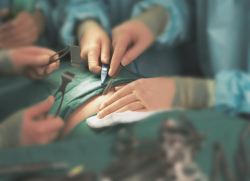Surgical Site Infections
Your skin is a natural barrier against infection. Even with many precautions and protocols in place to prevent infection, any surgery that causes a break in the skin can lead to an infection. Healthcare providers call these infections surgical site infections (SSIs) because they occur on the part of the body where the surgery took place. If you have surgery, the chances of developing an SSI are about 2% to 4%.
Types of surgical site infections
An SSI typically occurs within 30 days after surgery. The CDC describes three types of surgical site infections:
-
Superficial incisional SSI. This infection occurs just in the area of the skin where the incision was made.
-
Deep incisional SSI. This infection occurs beneath the incision area in muscle and the tissues surrounding the muscles.
-
Organ or space SSI. This type of infection can be in any area of the body other than skin, muscle, and surrounding tissue that was involved in the surgery. This includes a body organ or a space between organs.
Signs and symptoms of surgical site infections
Any SSI may cause redness, delayed healing, fever, pain, tenderness, warmth, or swelling. These are the other signs and symptoms of specific types of SSI:
-
A superficial incisional SSI may produce pus from the wound site. Samples of the pus may be grown in a culture to find out the types of germs that are causing the infection.
-
A deep incisional SSI may also produce pus. The wound site may reopen on its own, or a surgeon may reopen the wound and find pus inside the wound.
-
An organ or space SSI may show a discharge of pus coming from a drain placed through the skin into a body space or organ. A collection of pus, called an abscess, is an enclosed area of pus and disintegrating tissue surrounded by inflammation. An abscess may be seen when the surgeon reopens the wound or by special X-ray studies.
Causes and risk factors of surgical site infections
Infections after surgery are caused by germs. The most common of these include the bacteria Staphylococcus, Streptococcus, and gram-negative bacilli. Germs can infect a surgical wound through various forms of contact, such as from the touch of a contaminated caregiver or surgical instrument, through germs in the air, or through germs that are already on or in your body and then spread into the wound.
The degree of risk for an SSI is linked to the type of surgical wound you have. Surgical wounds can be classified in this way:
-
Clean wounds. These are not inflamed or contaminated. They don't involve operating on an internal organ with any bacteria normally within it.
-
Clean-contaminated wounds. These have no evidence of infection at the time of surgery but do involve operating on an internal organ that has a lower level of bacteria in it .
-
Contaminated wounds. These involve operating on an internal organ with a spilling of contents from the organ into the wound.
-
Dirty wounds. These are wounds that have a known infection at the time of the surgery.
These are other risk factors for SSIs:
-
Having surgery that lasts more than 2 hours
-
Having other medical problems or diseases
-
Being an older adult
-
Being overweight
-
Smoking
-
Having cancer
-
Having a weak immune system
-
Having diabetes
-
Having emergency surgery
-
Having abdominal surgery
Helping prevent surgical site infections
If you are having surgery, ask your healthcare provider what you can do to reduce your risk for a surgical site infection. It's important to stop smoking before surgery and to tell your surgical team about your medical history, especially if you have diabetes or another chronic illness. Also, avoid shaving in the skin area that the surgeon is planning to operate through.
No matter how curious they are, loved ones should not touch your wound or surgical site. Carefully follow your healthcare provider's instructions about wound care after surgery. Call your provider if you develop a fever or pus, redness, heat, pain or tenderness near the wound, or any other signs or symptoms of a surgical site infection.
Treating surgical site infections
Most SSIs can be treated with antibiotics. Sometimes additional surgery or procedures may be required to treat the SSI. During recovery, make sure that friends and family members wash their hands before and after they enter your room. Make sure all healthcare providers and other caregivers always wash their hands, too.
Medical Reviewers:
- Mahammad Juber MD
- Marianne Fraser MSN RN
- Raymond Turley Jr PA-C
